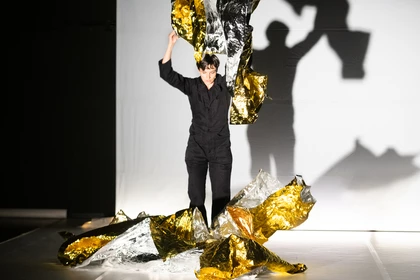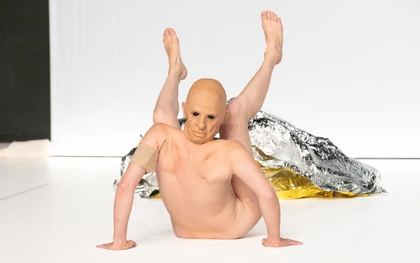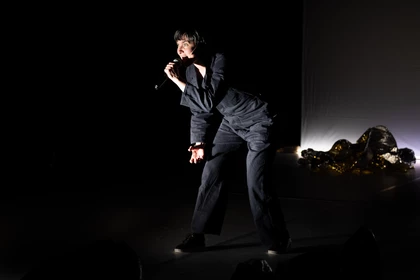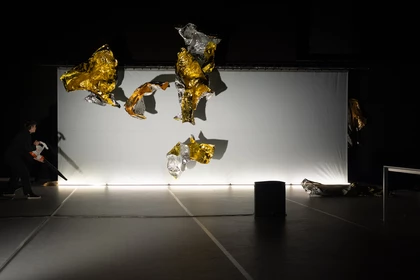Preserving the Essence —
Mette Ingvartsen and Manon Santkin Discuss the Living Archive of RUSH during Festival Legs.
La parole aux étudiant·es !
En parallèle de l'édition 2024 du festival LEGS, quelques étudiant·es du Master Art du Spectacle de l'ULB se sont prêté·es à l'exercice d'interview d'artistes choisi·es dans la programmation du festival. Ces articles sont réalisés sous la coordination de Antía Diaz Otero dans le cadre du module Préservation, présentation et réactivation des arts du spectacle.
Preserving the Essence —
Mette Ingvartsen and Manon Santkin Discuss the Living Archive of RUSH
RUSH is a solo performance by Mette Ingvartsen for Manon Santkin that honours 20 years of collaboration. It celebrates their joint work by revisiting and rewilding highlights from past performances. Santkin reshapes her work as a performer through storytelling and narration, embodying a diverse range of themes and atmospheres from the pieces she has performed in. The performance reflects artistic practice as a precious ecosystem, weaving together various elements to create a dynamic and energizing journey through a performance history.

ROY HANKACH: After reading descriptions of RUSH, I noticed that you use the term "ecosystem" to describe the totality of your work together. Could you elaborate on the choice of that word?
METTE INGVARTSEN: When we began working on RUSH, I wanted to reflect on our 20 years of collaboration, partly by focusing on "The Artificial Nature Project", a performance Manon performed in and contributed to in different ways. Ecology has in the past been a lens through which I view my work and revisiting those concerns felt timely. When we questioned the core of our common studio practices, we also realized that they require nurturing to flourish. We became interested in thinking about how to cross fertilize the creative processes we have been through, by trying to combine different pieces to create something new and unexpected. Just as ecosystems need time and care to regenerate, we thought artistic endeavours also mature and evolve over time. For example, the first solo I tried to create for Manon back when we were in P.A.R.T.S never really became something, or maybe rather it took 20 years to mature and is finally coming to fruition in RUSH.
Another metaphor that we thought of is the ant hill, where laborious effort contributes to the creation of art. Taking a closer look at our processes over time, we found that they involve continuous work and that ideas breed new ideas, transformations, and revivals. “The Artificial Nature Project” inspired us to explore the concept of using a single material in various ways, a theme we incorporated into RUSH with reflective materials recycled from this former project.
The central idea is to treat artistic practice as an ecosystem: ideas cross-pollinate, evolve, and regenerate, similar to the natural world. We attempt to foster creation through recycling, reusing, and reshaping materials, reflecting an ecological mindset in general.

R.H: If we were to consider this creative process, particularly in RUSH when you revisit your old work, do you feel like you rediscover your work during this process? When you take elements and integrate them into the present, does it yield another result or reveal another facet of something? What transformation occurs?
MANON SANTKIN: When I perform the pieces, they feel very familiar to me, not like retrieving something lost from a distant memory. But when we place these moments side by side, the connections and themes between the pieces reveal themselves differently. I wouldn’t say it’s a rediscovery, but a process of observing them side by side, where the connections become more pronounced.
For this creation, Mette pointed out my way of working with imagination in relation to performing, which I sort of took for granted. It feels intrinsic to our collaborative process– the way we integrate dance with imagination, extending physical movement into a realm of unseen narratives and scenarios.... I thus realized it's not necessarily a common approach, and that fact feels like a discovery.
M.I: For me, there was a defining moment when Manon performed what we call "viscosity" from “7 Pleasures”. Originally, it involved 12 naked bodies, but we decided to restage it with just Manon and the safety blankets, wondering if the blankets could replicate the mass of people. It exposed a connection to “The Artificial Nature Project”, because in that piece we were trying to create a non-human material movement resembling a mass moving across the stage. Despite the opposition of the two pieces - one focusing on non-human materials, the other on naked bodies - we discovered how closely they were connected.
By redoing fragments of these pieces, I think we uncovered connections, bridging abstract ideas with concrete expressions. As we chose fragments for the performance, we also noticed the contrasts between nudity and full body coverage. Rediscovering links between scenes, like the orgasm choir and the crying choir, also revealed a recurring theme that I hadn't noticed before, despite their creation being close together.

R.H: And how do you bind these different moments into a cohesive performance?Since they’re so interrelated, is it enough to just place them side by side?
M.I: I believe what Manon said about imagination binds it. There are parallel lines in the piece—it's both a retrospective and a new piece. We invented new scenes or reworked existing ones. When done alone, they didn't work because they're originally group pieces. Reworking materials speaks to the idea that material is nothing in itself. It's how you stage it, put it in relation to other things, and create a relationship to the audience that matters.
RUSH is made with Manon almost acting as a guide bringing the audience through different materials, which are unrelated yet stem from the experience of one body, her body. And I think because of that ithe piece still hangs together.
M.S: It's also a pleasure to create a new narrative from existing bits. The sequence you decide to place them in matters. There's pleasure in this new dramaturgy; contrast means something. A material or scenographic link can create a logical passage between two vastly different worlds.
Just because there was a table in both scenes, the audience's imagination can connect them easily. It corresponds to Mette's way of writing and composing. It's not just about the dramaturgy or logics of human actions, but also about links through light, sound, and meanings binding these elements together, particularly in RUSH. It’s also a pleasurable process to see how these different binds can create either contrasts or continuities.

R.H: Going back to this imagination. I’d like to know more because it is indeed a very particular way of using this tool in dance. How do you use this toolkit? How do you access this archive of things that are stored in you or in your body?
M.S: It is true that there are stored elements which brings back the question of imagination.
I'm convinced that dancing without imagination isn't possible. Everybody, all dancers are using their imagination on some level because even when dancers are performing fully written choreographies, they are translating them into something that makes sense to them, to something which they can reactivate in the moment.
When I'm reenacting group scenes, I partner with my imagination by establishing my anchors, which can sometimes be tactile and sometimes spatial. And I make an effort to recall the presence of other bodies to ground myself and react to these elements.
M.I: Actually, you make the others appear through language and description of people or things that are interacting with you. You're using imagination to reevoke collective scenes with other people that now are done by you alone.
M.S: In this piece, there's a notable amount of description and direct address to the audience. It involves a back-and-forth between two different timings: the timing of verbally describing something and the timing of sensing or embodying it.
I find it important to remind myself to take the time to embody the action I'm describing. Describing and talking can be busy work. Instead, I need to allow the action or situation I just talked about to unfold naturally for a moment. We switch between these different timings, which is crucial in terms of what aspect to enhance. This defines the possibility of experiencing for the audience as well.
M.I. Which makes me think that imagination is also a powerful tool in making things appear that are not there, similar to ekphrastic descriptions of artworks that are no longer present; they end up becoming more vivid in people’s imagination than their original existence.
In choreography, it’s not only about the body dancing, but also about imaginary extensions of the body and extensions into non-human agents and materials. I like to think about imagination also in relation to social or political realms; imagining and projecting things that are not there are necessary in order to make changes in the world possible, even if RUSH isn’t explicitly linked to a political context that is going on right now. The force and necessity of imagination is also one of the main reasons why we’re doing RUSH.

R.H: Which you do very explicitly in the piece “The dancing public”. You engage people in dancing and then with verbal language impart different meanings into their dance, charging it politically.
When discussing the role of audience imagination, and going back to RUSH how do you observe the responses of individuals who are unfamiliar with your past works versus those who are acquainted with them?
M.I: A lot of those who have seen the performances we refer to described grappling with a dual image – what they remember versus what it has become, because RUSH is a reiteration, and not the original piece. Some younger audience members who had not seen anything before told us that the precision of the descriptions made them follow this piece and believe in the authenticity of the narrations, yet questioning whether our portrayal also contained new fictions, or inventions of new scenes to address technical challenges.
History is always subject to interpretation, and our reimagining of past works is no exception. Each retelling shapes the narrative differently. Audience involvement is key in our performance. We want to create a collective experience for everyone, regardless of their exposure to the previous works. Manon's candid manner of speaking I think enhances this inclusive atmosphere, hopefully connecting with every member of the audience no matter their previous exposure.
R.H: It’s one thing to have worked projecting the audience in mind and it’s another thing to be confronted by them in the moment and after the performance, so what was that confrontation like for you after your première?
M.S: We made runs with a few people watching, of course it’s a big shift compared to the première, however it felt how I thought it would feel. Mainly because...
M.I: Good at imagination (chuckles)
M.S: I have verbally addressed the audience in previous performances and assumed the role of a figure who frames and reassures them. I also make use of this experience in RUSH. However, being a solo performer adds another level of pressure. I enjoy having to « host » and switching registers of address while doing so: I establish a significant fourth wall and then break it by speaking directly to you, addressing you as if we knew each other. Or more like a conference speaker, where it's not interactive. I address you throughout, with specific moments where I'll open the door for a response. You're welcome to answer, but it's not required. These shifts are an intriguing and challenging aspect of performing this piece for me.
R.H: Because of the unknown that could occur and you have something that is very structured on the show?
M.S :Yes.
R.H: Since the notion of preservation is so important and is a key notion in RUSH, I was wondering if you have any particular approach to archiving or preserving the spectacle itself. In other terms, how do you see it being archived?
M.I: Good point, although we haven’t considered how we will be archiving it yet. There's a challenge in preserving live performances because video recordings, while useful for memory, don't capture the full experience. Creating RUSH is our way of addressing this, seeking a live archive instead of traditional documentation like a picture book. I think that live performances should be archived live, to be able to convey the presence of the performance - RUSH serves as a living archive, closely tied to Manon's experience and performance quality.
Preservation in performance is tricky, as traditional methods like writing or pictures often fall short, especially for pieces focusing on non-human elements. Language, for me, extends the body, allowing me to articulate the conceptual underpinnings of my work. RUSH attempts to preserve not only the physical expression but also the thinking process that we went through. However, it's challenging to capture everything within the constraints of RUSH.
We mention many pieces briefly, so it's not a thorough exploration. However, the language provides glimpses into these worlds, summarizing complex ideas in a condensed time.
An interview with Roy Hankach on March 8th 2024